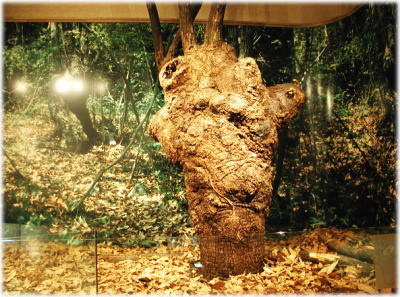Exhibition
Nature Square
Nature of Osaka
The nature left behind in Osaka from advanced urbanization. We can learn about the organisms that live in Osaka, and our relationships with them in this exhibition hall. There are permanent exhibits on the living organisms, stratum, and rocks that can be found in the sea, plains, hills, and mountains surrounding the three sides of Osaka. We will also be introducing nature observation courses for the nearby areas.
1 Geological History of Osaka District


Osaka is surrounded by the Hokusetsu Mountains in the north, the Kongo-Ikoma Mountains in the east, and the Izumi Mountain Range in the south. There are hills at the foot of the mountains where the plains spread over the lowlands all the way to Osaka Bay. Rocks and stratum from the ancient eras can be found in the mountainous land, and the hills and plains are made of stratum in the newer eras. There are active faults in the plains and between the hills and mountains. Due to the movements along the active faults which started at about a million years ago, the mountain ranges and plains were respectively uplifted and lowered about once every thousand years from earthquakes, leading to the present geographical structure.
2 Climate and Vegetation

There are regional climate differences in that the northern area of Osaka has cool summers and snowy winters, the central area is dry with little rain, and the southern area is balmy and rainy.
In addition, the climate in the mountainous areas in the Kii Peninsula is colder and wetter. These climatic differences are manifested in the vegetation in the forests and woods in the central and southern areas, where one can see broadleaf evergreen trees in the central and southern areas, beech forests in the northern and mountainous areas, and spruce forests that prefer colder temperatures on top of Oomine and Oodaiyama mountain ranges.
3 Osaka Bay


The Osaka Bay reaches deep into the northeast of the city where huge rivers such as the Yodo River drains into it. The shallow sea floor around the bay is characterized by shallow waters and muddy substrata. In addition, as the river water is abundant with rich organic matter and nutrients, many living creatures grow in the bay.
4 Yodo River



The Yodo River is the largest river in Osaka that drains into the Osaka bay. It flows throughout the big city where there are reed plains filled with rare plants alongside the river. There are many such places left behind that are blessed with Nature including fluvial lagoons (treasure trove of water bodies) and tidal flats abundant with crabs and shellfish.
5 Osaka Plain


The Osaka plain was originally a wetland that expanded downstream of the Yodo River and the Yamato River. Rice cultivation began in the early Yayoi period (ca 300 B.C. to ca 300 A.D.) and much of the wetland was transformed into rice paddies. Since the 1960s, the are has undergone rapid urbanization and only several rice paddy fields remain now. While the number of organisms living in the wetlands and rice paddies has greatly decreased, some species are increasing in numbers in urban areas and reclaimed areas and so on.
6 Hills



The Osaka Plain is surrounded by hills that were once covered by copses and terraced rice paddies with small villages and human settlements scattered in the valleys. But after the 1960s, people began to change their ways of living and the woodlands lost its economic value. With the expansion of the city, the village forests and woodlands environment has been reduced to a narrow strip.
7 Wetland


We have many waterside environments such as rivers, waterways, irrigation ponds, paddy fields and wetlands. The different water depth, water quality and current movement in each waterside environment has led to the growth of different communities of living organisms. The paddy fields and irrigation ponds initially built for agriculture are important habitats for living creatures and organisms.
8 Mountainous Regions



The three mountainous regions of Osaka, the Hokusetsu, Kongo-Ikoma, and Izumi mountain ranges, have their own distinct geological and geographical characteristics although the climates are very similar. However, due to the utilization of the local inhabitants over the years and the original state of the forests, each mountain range now has its own unique nature and landscape. Recently, urban development of the city has extended to the mountainous regions and the once beautiful landscapes are in the midst of being destroyed since the people involved in agriculture and forestry have decreased.
9 Nature Information Corner

At the Nature Information Corner, we will be introducing many fossilized specimens, fossils and rocks that one can actually observe in Osaka. At the Nature Information Corner, you can find out more information before you go for nature observation trips or look up the samples of specimens you discovered.
Nature observation map
We hope that you will go outdoors and be familiar with Osaka's nature using the Map on Nature Observation as a guide. Please visit our museum again to find out what you can explore or discover in the fields.
Museum Shop

You can buy goods on the actual exhibits and books on natural history in the Museum Shop or at Nature Square.